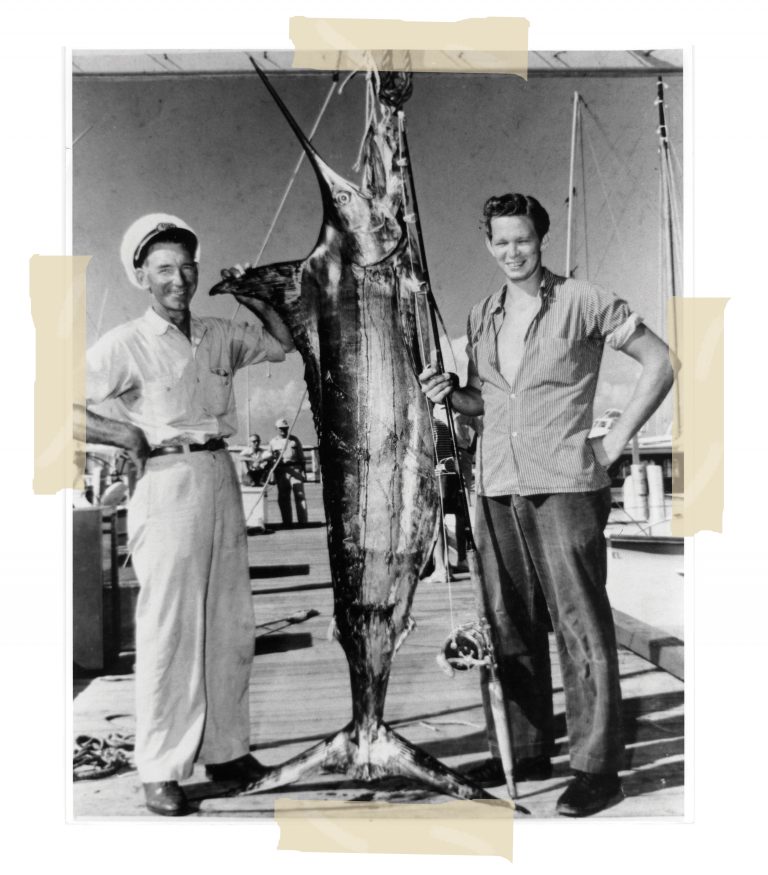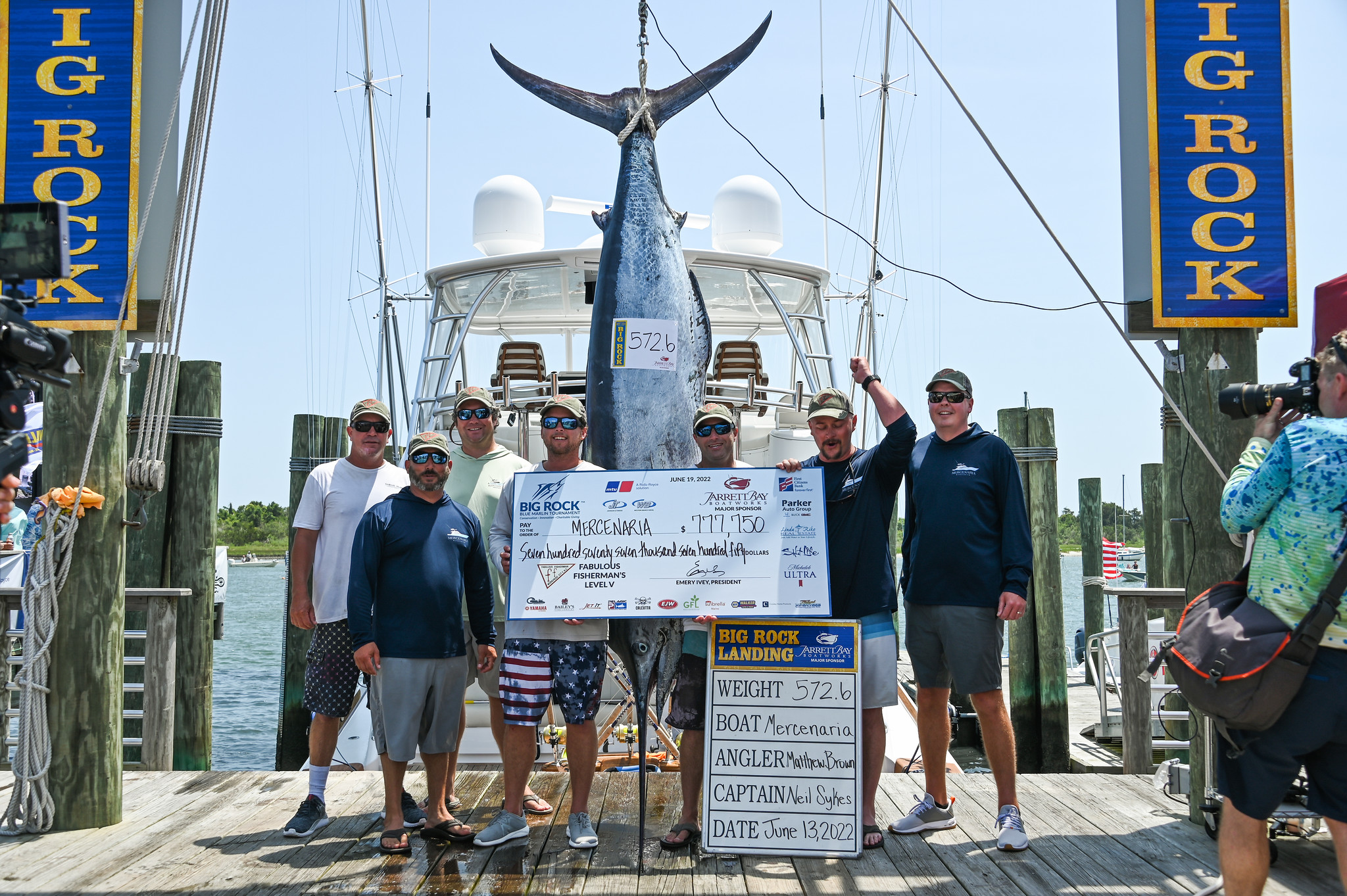BIG ROCK HISTORY
When billfish competitors begin to register for the 64th annual Big Rock Blue Marlin Tournament, they take their first step toward winning part of the richest Blue Marlin Tournament’s multimillion-dollar purse.
That’s quite a change from the original Big Rock prize: a child’s red wagon filled with silver dollars.
To understand this transformation, you need to travel back in time to the spring of 1957. Back then, no one was certain that billfish existed in the waters off the North Carolina coast. Commercial fishermen in those days seldom ventured beyond the sight of the coastline. Their families had worked coastal waters for generations, yet no one had ever seen these fish. Sailors who worked the commercial freighters that traveled in and out of the Morehead City port insisted they’d seen blue marlin not too far offshore

Most locals dismissed this as “bar talk’’ since the deck hands didn’t know where they were at the time of the sightings. Since blue-marlin skeletons never washed up on the beach, these reports were believed to be idle chatter. Still . . . the rumors persisted. But a few wishful thinkers hoped the stories were true. Bob and Mary Simpson, Bill Strickland, Tom Potter, and Dick Parker decided to settle the issue once and for all.
Together they created the Fabulous Fishermen Club — a loose-knit organization of Morehead City fishing enthusiasts. The Club partnered with several local merchants to announce they would pay a cash prize to the first person who could catch a blue marlin in the waters just off the Crystal Coast. That cash prize did the trick. Intended to promote deep-sea fishing and to help support the area’s infant charter boat industry, it encouraged anglers and captains to head further offshore. Fishermen sighted blue marlin throughout that summer.
Despite the sightings, no one was able to land the beautiful, elusive fish. Those summer failures gave way to an autumn success. On September 14, 1957, Raleigh angler Jimmy Croy, fishing aboard the Mary Z with Capt. K.W. “Bill’’ Olsen, landed a 143-pound blue marlin. This special catch forever changed the face of Crystal Coast fishing.

SOUND THE SIRENS Before Croy’s marlin ever reached shore, Olsen radioed Bump Styron, who owned the Morehead City Yacht Basin, to report the historic catch. Styron, in turn, notified Bob Campbell — WMBLAM Radio’s “Voice of Fishing’’ for 37 years — and he got the word out to the public. Soon after that, a crowd of about a hundred gathered at Styron’s yacht basin to await the arrival of the “big’’ fish. In the meantime, Tony Seamon and his son, Tony Jr., went to First Citizens Bank where bank president Jim Bob Sanders kept a sealed sack of silver dollars. Tony Seamon Jr., was given the task of counting out the prize money. He poured the coins into a little red wagon, a child’s toy donated just moments before by the manager at Rose’s department store. Then, amid police sirens, car horns, and as much vocal ruckus as could be mustered, the red wagon was pulled through the streets of Morehead City to the place where the fish would arrive. It was the first celebration of an event that would soon become the Big Rock Blue Marlin Tournament, an event that brings thousands to the waterfront each June.
HUMBLE BEGINNINGS A picture of that famous first marlin appeared in the September 17, 1957, edition of the Carteret County News-Times. Ironically, the event merited just three paragraphs on an inside page. No other pictures of the fish are known to exist. Since nobody knew what the Big Rock would become, nobody kept accurate records in those early years. Reports on the amount of the first cash prize vary from $250 to $500. Tony Seamon Jr. told Big Rock officials that he remembered counting out 500 silver dollars into that little red wagon. Campbell reported that the prize was only $325 and later revised that amount to $300. Dick Parker, a charter member of the Fabulous Fishermen Club, insisted that the first prize was $250 and grew to $325 in subsequent years. Confusion as to the amount of that first prize exists to this day. Still, these quaint beginnings gave birth to the Big Rock Blue Marlin Tournament as it is known today — a nationally-sponsored competition that’s famous throughout the world for huge cash prizes. That first prize, whether $250 or $500, pales in comparison to the millions of dollars that have been pocketed by competitors the past several years.
TOURNAMENT CHANGES Over the years, the annual competition has changed its name, altered its format, adjusted its sponsorship, and modified its rules. The Big Rock board of directors continues to fine-tune the event to ensure the tournament always represents good times and great fishing.
CONSERVATION EFFORTS A strong focus on conservation Billfish preservation has remained a primary concern for Big Rock tournament officials and competitors for more than a decade. Twenty-one years ago, the Big Rock Blue Marlin Tournament’s board of directors raised the minimum weight limit to land a blue marlin to 400 pounds. The 400-pound weight limit was, at the time, 200 pounds above regulations set by the federal government. Tournament rules adopted in 1997 require Big Rock anglers to release all blue marlin that do not weigh more than 400 pounds or measure at least 110 inches in length. The tournament rewards boats with the most release points daily and over the week-long tournament. Anglers who bring blue marlin to the scales that do not meet these minimums are penalized. Marine biologists take charge of blue marlin brought to the weigh station so they can study and research this important species. Representatives from the NC State University Center for Marine Science and Technology (CMAST) collect samples at the weigh station of all gamefish and blue marlin weighed in. Proceeds from every Big Rock tournament are donated to support organizations that are dedicated to helping pelagic species flourish. In 2021, Big Rock partnered with the International Gamefish Association (IGFA) to deploy satellite tags on Blue Marlin for the first time off the US East Coast. LO QUE SEA tagged a blue marlin which traveled 5,196nm. That satellite tag is potentially the longest blue marlin track ever collected by the IGFA and the second-longest track of all time for any billfish species.
INTERNATIONAL COMPETITORS The Big Rock is a prestigious marlin tournament that attracts competitors from around the world. In recent years, anglers from 22 states and three international teams have participated in the six-day offshore competition. Winning the Big Rock has become the focus of many top billfish competitors.

LADY ANGLERS While many people consider blue marlin fishing a “man’s” sport, it is the ladies who have dominated the headlines. In 1993, Kathy Keel of Edenton landed a 759-pound blue marlin to win the 35th annual Big Rock. She held the all-time Big Rock record until June 15, 2000, when Ron Wallschlager of Kiawah Island, S.C. reeled in an 831-pounder to win the 42nd Big Rock. That record was shattered in 2019 when Todd Dickerson of Fenwick Island, DE weighed in a 914-pound monster on the last day of the 61st Annual Tournament. To this day, Kathy’s catch remains one of the top three fish to ever hit Big Rock’s scales. In 2005, Gigi Wagoner of Fredrick, MD, became the fourth woman to win the Big Rock. Fishing aboard the Ocean City-based charter boat Size Matters, Wagoner reeled in a 529-pounder. Anglers like Keel and Wagoner were the inspiration behind the 1998 creation of a one-day ladies-only tournament that serves to introduce women to sports fishing. In 2022, the twenty-fifth annual Keli Wagoner Lady Angler (KWLA) Tournament drew a record 216 boats. Nearly 900 competitors battled for prize money in gamefish and billfish release divisions. Since its inception, the KWLA event has raised more than $425,000 for charity.
HEREOS ON BOARD Of course no one would have the freedom to fish if it weren’t for the brave men and women who serve our country. During the 60th Annual Tournament, the Big Rock Big Hero program was born. Since its inception, the initiative has placed active-duty servicemembers onboard with world-renowned crews and captains. In its inaugural year, USMC Col. T.J. “Bucket” Dunne was invited to fish aboard Fender Bender on the last day of the tournament. He released one blue marlin but was quickly told to “sit back down.” After an hour fight, Bucket boated the 514.3lb fish to take second place in the entire tournament!
PASSING THE TORCH The Big Rock tournament has long recognized young anglers who compete alongside seasoned deep-sea fishing veterans during the week-long event. The tournament rewards Jr. Anglers for top gamefish weighed in, and overall release points. In 2019, Jr. Angler Michael Cripe earned the crew of Job Site a whopping $368,250 for his 53.7lb Dolphin! Promoting sportfishing and marine education throughout the state of North Carolina has remained a top priority for the tournament. In hopes to grow the sport, the board of directors voted unanimously to add the Big Rock Kids Billfish Tournament to their schedule for 2021. The Kids tournament is the first of its kind, rewarding Jr. Anglers an extra 25 points for each billfish released. The primary purpose of the tournament is to raise additional funds for children’s charities. The Big Rock Kids Tournament hosted 59 boats and boasted a $152,824 purse in its inaugural year.
A BIG ROCK TRADITION: CYBER CAST COVERAGE Big Rock fans have enjoyed outstanding tournament coverage ever since the competition became an online event. Fans of the competition follow the offshore action on the tournament’s website, social media, and app. Competition updates are provided just seconds after a hookup is reported to tournament headquarters. You can even listen to the radio live via the Big Rock website. Big Rock board member, Randy Ramsey mans the radio from the early morning hours ‘till the last fish has hit the scales daily. One of the spectator’s favorite traditions is the blessing of the fleet Randy gives every morning, inspired by Captain Omie Tillet.
Throughout the tournament, staff members work long hours to provide live weigh-in coverage and up-to-the-minute reports about offshore action. Weigh-ins and exclusive interviews are captured by Big Rock TV, started in 2008 to commemorate the 50th Annual Tournament. Big Rock TV has now become an international sensation with over 2 Million viewers in 80+ countries during the 2022 tournament.
QUIET BEGINNINGS In the early years, the Big Rock could barely be considered a tournament. There were no rules of consequence, and only a few boats participated. When prizes became part of the affair, the total booty looked like the results of a scavenger hunt. In 1965, a listing of the prizes included one quart of varnish.
Limitations were few. Generally speaking, a member of the Fabulous Fishermen Club — a collection of Morehead City fishing enthusiasts — won the Big Rock if he docked the first blue of the season. This catch had to happen before a November 1 cutoff date. Tournament growth was slow. In 1958, George Bedsworth, captain of the Dolphin, pocketed a $325 prize. It would take years for the tournament to grow into the giant that is now known as the Big Rock.
In 1960 and 1961, “Fab Fishermen’’ didn’t even recognize previous efforts. The 1960 event — won by angler Carroll Williams of Petersburg, Virginia, aboard the Bunny Too captained by Arthur Lewis of Morehead City — featured a special Pfleuger Trophy provided by world-renown taxidermist Al Pfleuger of Miami, FL. Pfleuger would continue to mount the winning Big Rock fish for the next several years.
The 1963 edition of the tournament, and the one that immediately followed, sought to find out who could boat the most blue marlin. The ‘63 tournament concluded with 64 blue marlin brought to the scales. This huge number of blue marlin makes it hard to imagine that less than six years before, no one had ever caught a blue marlin off the Carteret County coast. In fact, Croy’s catch on the Mary Z was something that came about quite by accident. The only reason the Mary Z was out in 50 fathoms of water that day was because Olsen was giving the Mary Z its first test in ocean waters. Olsen had just finished building the craft for Bryan Rock and Sand Co. of Raleigh, NC. He took Croy as his “party’’ that day . . . to show him the warm offshore waters located in the Gulf Stream. Once there, Croy had the experience of a lifetime. After a 38-minute battle, the area’s first blue marlin was landed. Olsen had jokingly bragged he would catch the first marlin only days before this test run. He celebrated the catch late into the night with several of his Fabulous Fishermen Club friends. But nobody in the raucous group had any idea what was about to come.
GEOMETRIC CHANGES From humble beginnings — a simple challenge to catch the first blue marlin — the event grew into an annual contest. Year after year, the event became more structured as new rules were added. The “Fabulous Fishermen’s Blue Marlin Tournament’’ was renamed the “Big Rock’’ in 1972 because that was the spXot in the Gulf Stream where everyone went to fish. After a dozen years, entries in the tournament began to grow. The handful of boats during the early years led to 35 boats in 1970. The tournament topped 111 boats in 1979 and a record breaking 270 boats in 2021. The Big Rock currently averages 200 boats and nearly 1,600 competitors. Cash prizes have grown by leaps and bounds. In 1974, the winning boat received just $800. Ten years later, the purse nearly reached $70,000. Big Rock fans were thrilled when the 1988 purse topped $90,800. In today’s tournament, the total purse has averaged $2,621,830 in the last five years, with 2022’s record breaking purse of $5.85 million . That total is dwarfed by the $7.5 Million the Big Rock Foundation has donated to local charities. Entry fees have changed dramatically as well. A $25 tournament charge was all that was required early on. As late as 1973, inclusion in the tourney cost $75.
But as the prize money grew, so did entry fees. To enter Level I, Level II and Level III in the 1993 tournament, anglers needed to pay $2,200 to tournament officials. The entry fee (for all levels) in 2022 was $47,500 — which exceeds the combined total purses of the first 15 Big Rocks.
INTO THE FUTURE Who could predict the amazing growth of the Big Rock Tournament during the first 64 years of its existence? The people who viewed the first celebration had no hint of what was to come. What developments will carry the tourney into the next century? Perhaps the event will span two weeks, as it did in its infancy. Perhaps special instruments will be invented that have the ability to measure the size of a blue marlin through radio telemetry so that boating these fish becomes a thing of the past. Only time will tell.
Maybe the time will come when all boats will be outfitted with special cameras. Big Rock headquarters on the Morehead City waterfront already has the capability to communicate with its offshore competitors. Cameras would verify catches and relay fishing action back to shore. The same cameras that right now put NASCAR fans into the driver’s seat of a race car could soon transport fishing enthusiasts offshore. That would bring Big Rock fishing into the homes of millions of fans.
Perhaps international divisions will be formed to pit U.S. teams against anglers from other countries. Last year, a team from Puerto Rico nearly finished in the money. The competition has a tremendous potential to grow and has become one of the top billfish competitions in the world.
Since some people already call the Big Rock the “Super Bowl of fishing,’’ perhaps others will begin to call that late January football game the “Big Rock’’ of football. Whatever happens, it’s been a wild and wonderful journey. And it all began a little more than 64 years ago when Jimmy Croy and Bill Olsen hooked a very special 143-pound fish.

“The Big Rock is an area of hard bottom situated approx. 35 miles southeast of Morehead City. The structure’s location along the continental shelf in 180 to 500 ft. of water is unique since it is generally in the gulf stream current. The Big Rock’s location along with the dramatic upwellings of structure provides an outstanding fishing location.”
